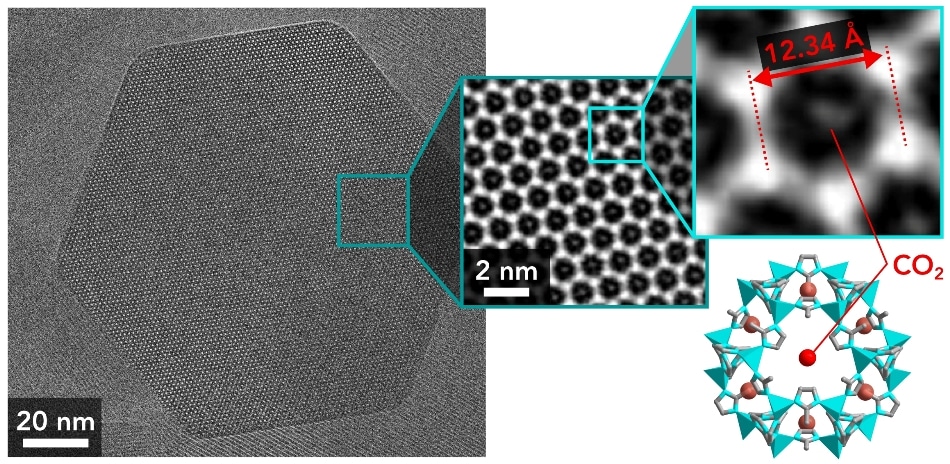Jun 27 2019
A new variation on cryo-EM imaging shows what is happening within MOFs, highly porous nanoparticles with a great capacity for storing fuel, isolating gases, and eliminating carbon dioxide from the atmosphere.
 Cryo-EM images show a slice through a single MOF particle in atomic detail (left), revealing cage-like molecules (center) that can trap other molecules inside. The image at right shows carbon dioxide molecules trapped in one of the cages – the first time this has ever been observed. Bottom right, a drawing of the molecular structure of the cage and the trapped carbon dioxide. (Image credit: Li et al., Matter, 26 June 2019)
Cryo-EM images show a slice through a single MOF particle in atomic detail (left), revealing cage-like molecules (center) that can trap other molecules inside. The image at right shows carbon dioxide molecules trapped in one of the cages – the first time this has ever been observed. Bottom right, a drawing of the molecular structure of the cage and the trapped carbon dioxide. (Image credit: Li et al., Matter, 26 June 2019)
Researchers from the Department of Energy’s SLAC National Accelerator Laboratory and Stanford University have captured the first images of carbon dioxide molecules inside a molecular cage—a portion of a highly porous nanoparticle called metal-organic framework, or MOF, with huge promise for isolating and storing gases and liquids.
The images taken at the Stanford-SLAC Cryo-EM Facilities exhibit two arrangements of the CO2 molecule in its cage, in the so-called guest-host relationship, show that the cage expands to some extent when the CO2 gets in; and zooms in on uneven edges where MOF particles may develop by adding more cages.
This is a groundbreaking achievement that is sure to bring unprecedented insights into how these highly porous structures carry out their exceptional functions, and it demonstrates the power of cryo-EM for solving a particularly difficult problem in MOF chemistry.
Omar Yaghi, Professor, University of California, Berkeley
Yaghi is also a pioneer in this area of chemistry, who was not involved in the research.
The team of scientists, headed by SLAC/Stanford professors Yi Cui and Wah Chiu, has reported the research in the journal Matter on June 26th, 2019.
Tiny Specks with Enormous Surfaces
MOFs possess the biggest surface areas of any known material. Just one gram, or three-hundredths of an ounce, can have a surface area of almost the size of two football fields, providing ample space for guest molecules to enter millions of host cages.
Although MOFs have huge commercial promise and 20 years of powerful, accelerating research, they are just now beginning to reach the market. Researchers around the world design over 6,000 new kinds of MOF particles every year, seeking the right combinations of chemistry and structure for specific jobs, for example, improving the storage potential of gas tanks or capturing and burying CO2 from smokestacks to fight climate change.
According to the Intergovernmental Panel on Climate Change, limiting global temperature increases to 1.5 degrees Celsius will require some form of carbon capture technology. These materials have the potential to capture large quantities of CO2, and understanding where the CO2 is bound inside these porous frameworks is really important in designing materials that do that more cheaply and efficiently.
Yuzhang Li, Study Lead Author and Postdoctoral Researcher, Stanford University
TEM or transmission electron microscopy is one of the most powerful techniques for observing materials and it can generate images in atom-by-atom detail. However, several MOFs, and the bonds holding guest molecules inside them, melt into blobs when subjected to the strong electron beams essential for this kind of imaging.
A couple of years ago, Cui and Li adopted a technique that has been employed for several years to examine biological samples: Freezing samples so that they endure better when bombarded by electrons. The duo employed a sophisticated TEM instrument at the Stanford Nano Shared Facilities to investigate flash-frozen samples comprising of dendrites—finger-like projections of lithium metal that can penetrate and impair lithium-ion batteries—in atomic detail for the first time.
Atomic Images, One Electron at a Time
For this latest research, Cui and Li employed instruments at the Stanford-SLAC Cryo-EM Facilities, which have much more sensitive detectors. These detectors can take up signals from individual electrons passing through a sample. This enabled the researchers to create images in atomic detail while reducing the electron beam exposure.
The MOF they examined is known as ZIF-8. It came in particles which were just 100 billionths of a meter in diameter; around 900 of them have to be lined up in order to match the width of a human hair.
“It has high commercial potential because it’s very cheap and easy to synthesize,” stated Stanford postdoctoral researcher Kecheng Wang, who played a vital role in the experiments. “It’s already being used to capture and store toxic gases.”
In addition to allowing them to create extremely sharp images with minimal damage to the particles, the Cryo-EM also prevented the CO2 gas from escaping when its image was being taken. Imaging the sample from two angles allowed the investigators to verify the positions of two of the four places where CO2 is assumed to be weakly held in place within its cage.
I was really excited when I saw the pictures. It’s a brilliant piece of work. Taking pictures of the gas molecules inside the MOFs is an incredible step forward.
Robert Sinclair, Professor, Stanford University
Sinclair is also an expert in using TEM to study materials and helped interpret the team’s outcomes.
The National Institutes of Health and the Department of Energy offered major funding for this study.